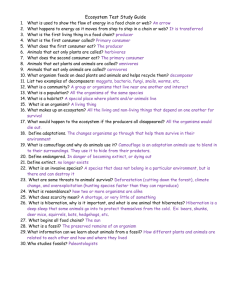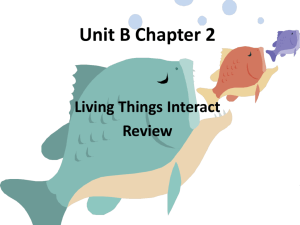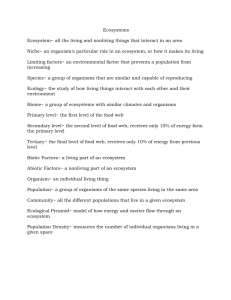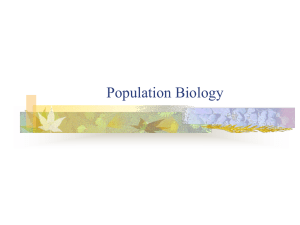Ecosystem Project Notes
advertisement
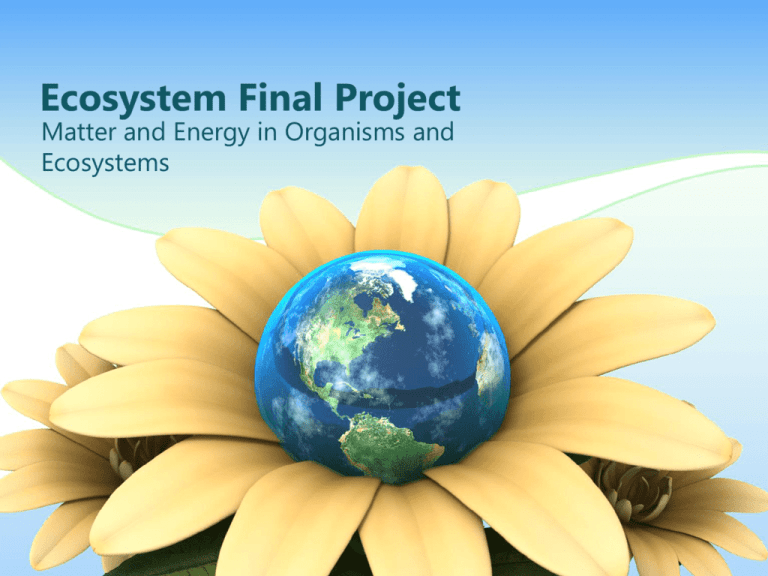
Ecosystem Final Project Matter and Energy in Organisms and Ecosystems The study of interactions among organisms and between organisms and their environment, or surroundings ECOLOGY Species Populations Communities Ecosystem Biome LEVELS OF ORGANIZATION A group of organisms so similar to one another that they can breed and produce fertile offspring SPECIES Groups of individuals that belong to the same species and live in the same area POPULATIONS One Hungry Planet THE JOB OR ROLE OF THE ORGANISM • the type of food an organism eats •the organism’s type of shelter • the predators that eat it •the time of day it is active NICHES A collection of all the organisms that live in a particular place, together with their non-living, or physical environment. ECOSYSTEM Food Webs and Trophic Levels Energy Transfer in Food Webs About 10 percent of net energy production at one trophic level is passed on to the next level. Processes that reduce the energy transferred: • • • • • Respiration Growth and reproduction Defecation Non-predatory death Nutritional quality Producers plants and other organisms capable of carrying out photosynthesis. Decomposers organisms that convert dead matter into gases such as carbon and nitrogen to be released back into the air, soil or water primarily bacteria and fungi necessary for recycling nutrients to be used again by producers Consumers organisms that eat something else Primary Consumers: eat producers Herbivores Secondary Consumers: eat primary consumers Omnivores and Carnivores Tertiary Consumers: eat secondary consumers Energy is “lost” of becomes “disorganized” as it is transferred to heat. ENTROPY diagram which completely illustrates the transfer of chemical energy within and ecosystem FOOD WEB Ecosystem models typically simplify the systems they are studying to a limited number of components that are well understood, and deemed relevant to the problem that the model is intended to solve. ECOLOGICAL MODELS A sample of the population is taken, the animals are marked, released, and a second sample is taken. After their initial release a proportion of the population will be marked. The proportion of marked animals in the second sample should reflect the proportion of animals marked in the entire population. For example, suppose that 10 animals were marked and released in the first sample. If 50% of the animals in the second sample are marked, then you can assume that 50% of the animals in the population are marked. The 10 animals in the first sample therefore represent approximately 50% of the population, so the population = 20. MARK & RECAPTURE You could count every individual organism in an ecosystem, but you could imagine how long this would take for small plants in a large area - just imagine trying to count all of the individual blades of grass in a football field! When conducting ecology research, scientists often select several smaller sample plots inside a larger study area. The scientists thoroughly study the smaller areas, and use information from these plots to make generalizations about the larger study area. PLOTTING Human population density vs global vegetation patterns Carrying Capacity – Maximum population size an environment can sustain. Population Density = People per km2 PLANTS AND PEOPLE TYPES OF POPULATION CURVES Increasing the same amount at regular intervals LINEAR CURVE The number of intervals added to the population gets larger during each time interval EXPONENTIAL CURVE When a species is introduced there is rapid growth due to ample resources and few predators. Eventually the growth levels off when the population reaches the carrying capacity. S CURVE Types of population curves S- Curve • • When a species is introduced there is rapid growth due to ample resources and few predators Eventually the growth levels off when the population reaches the carrying capacity



